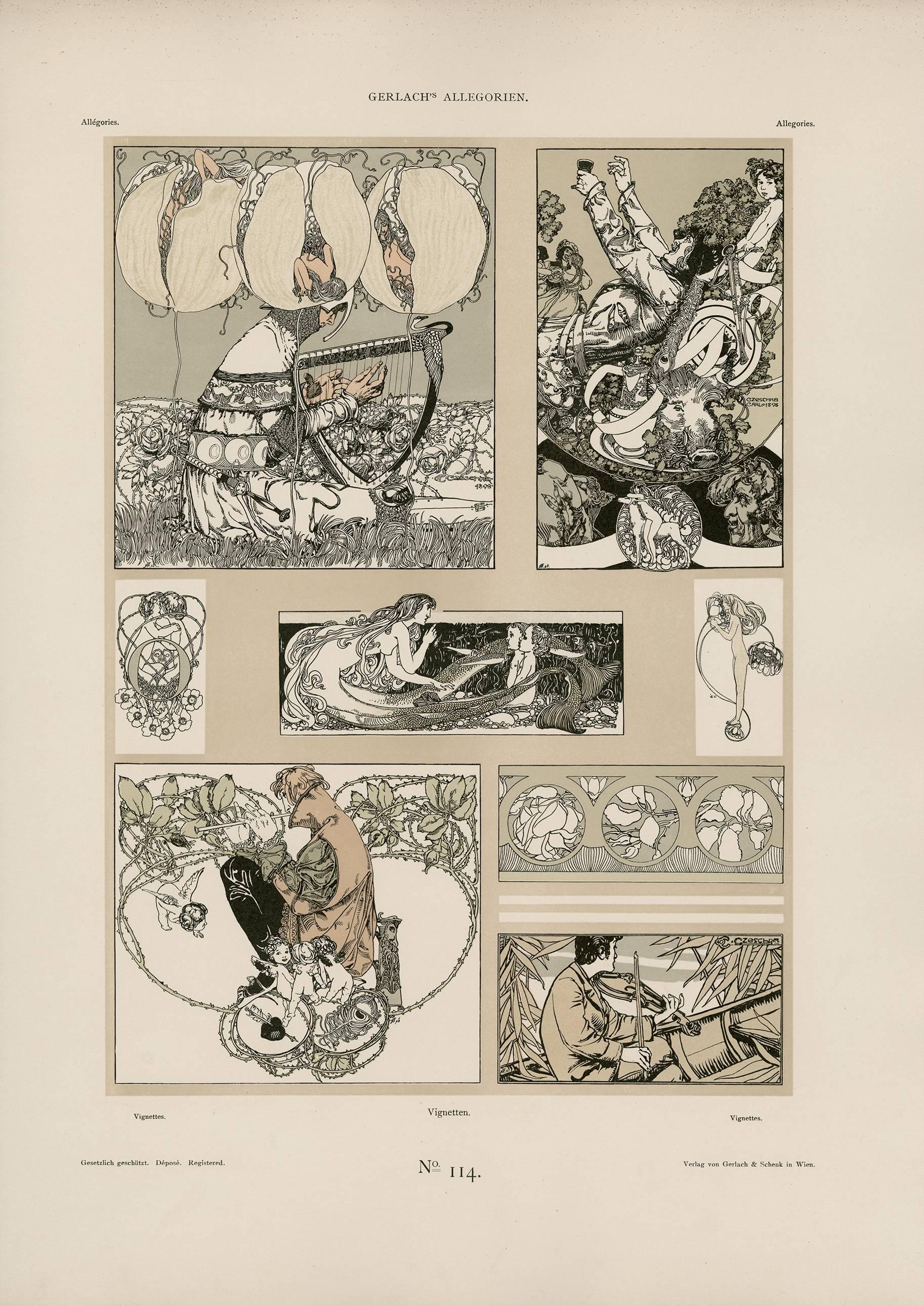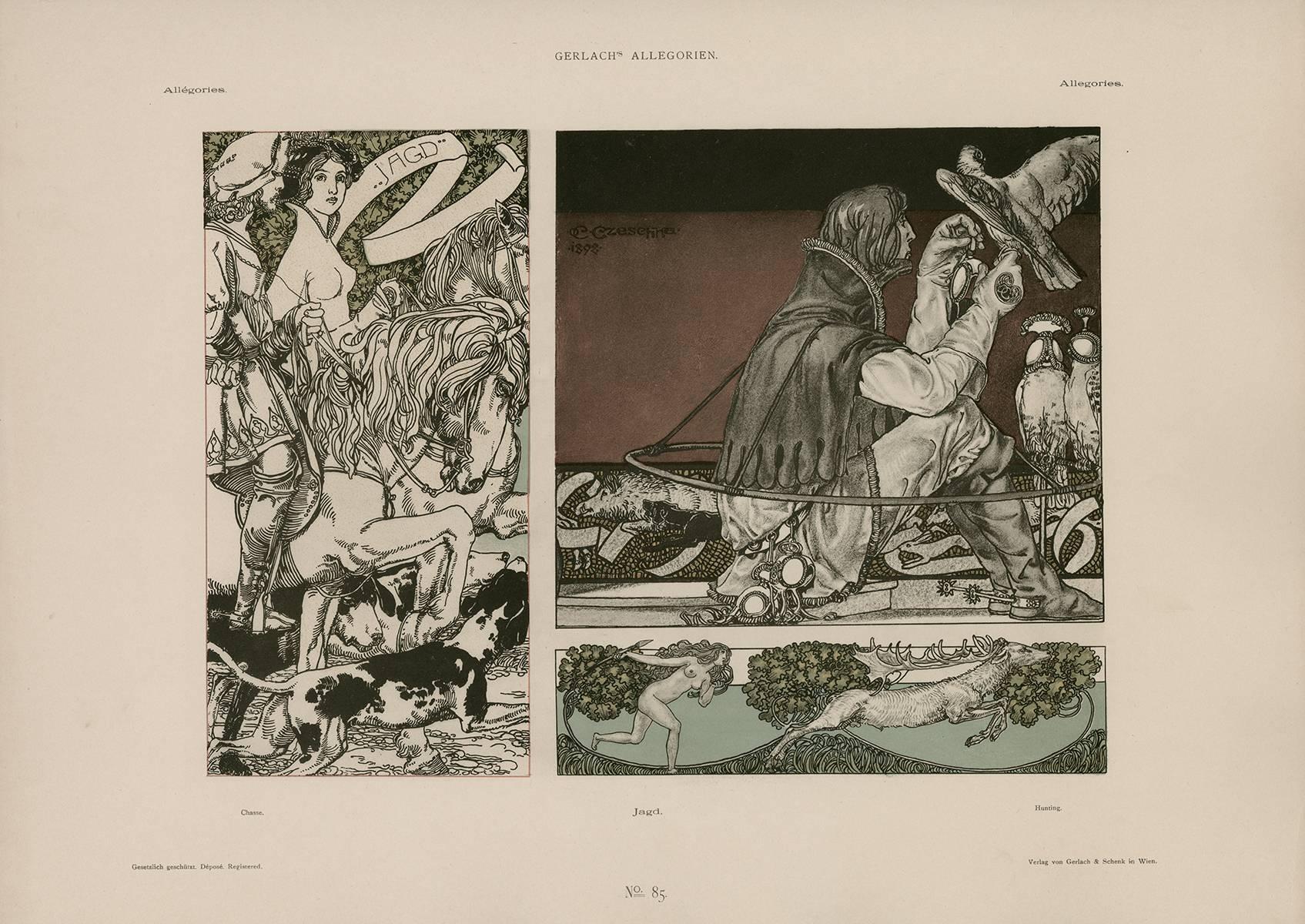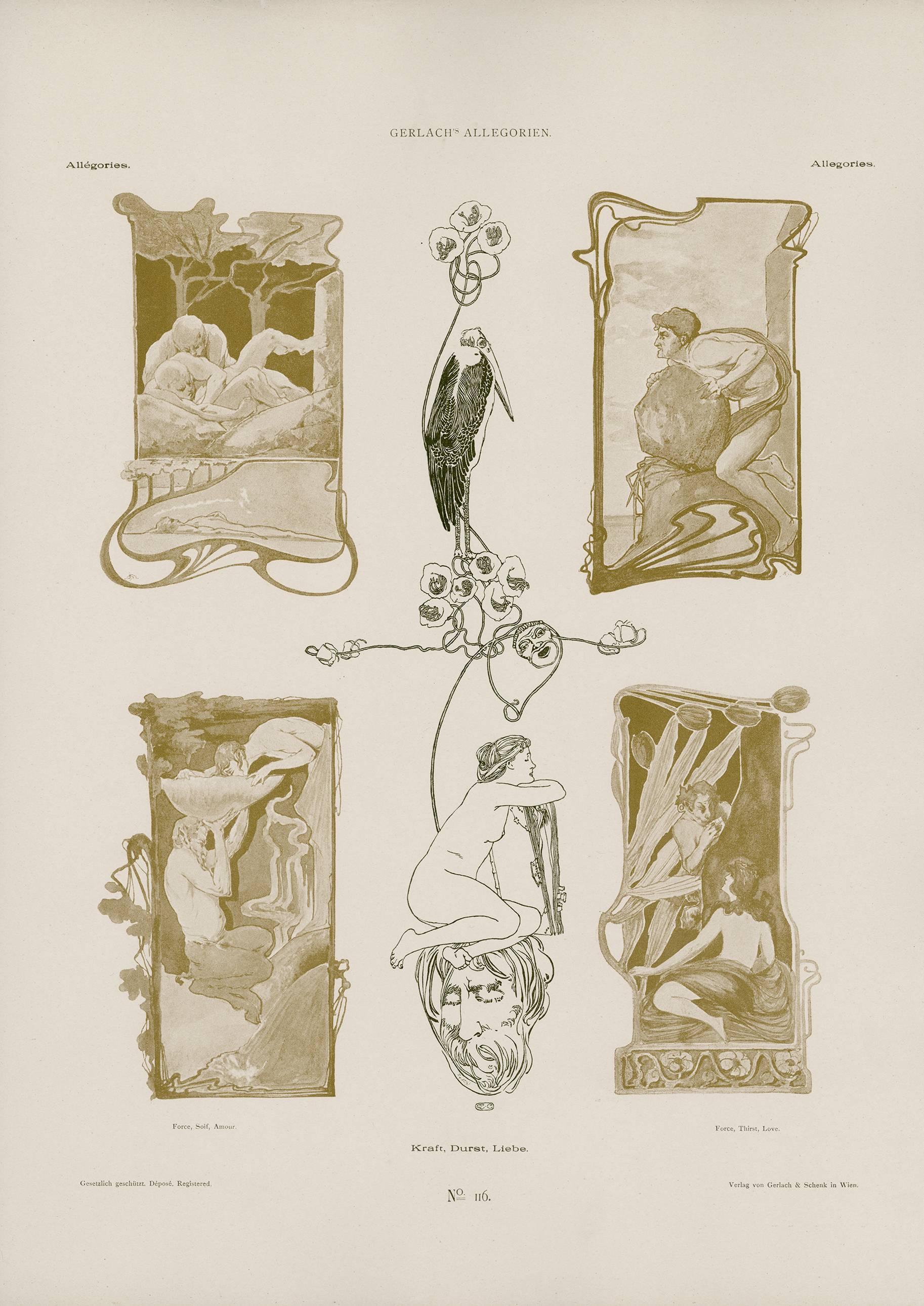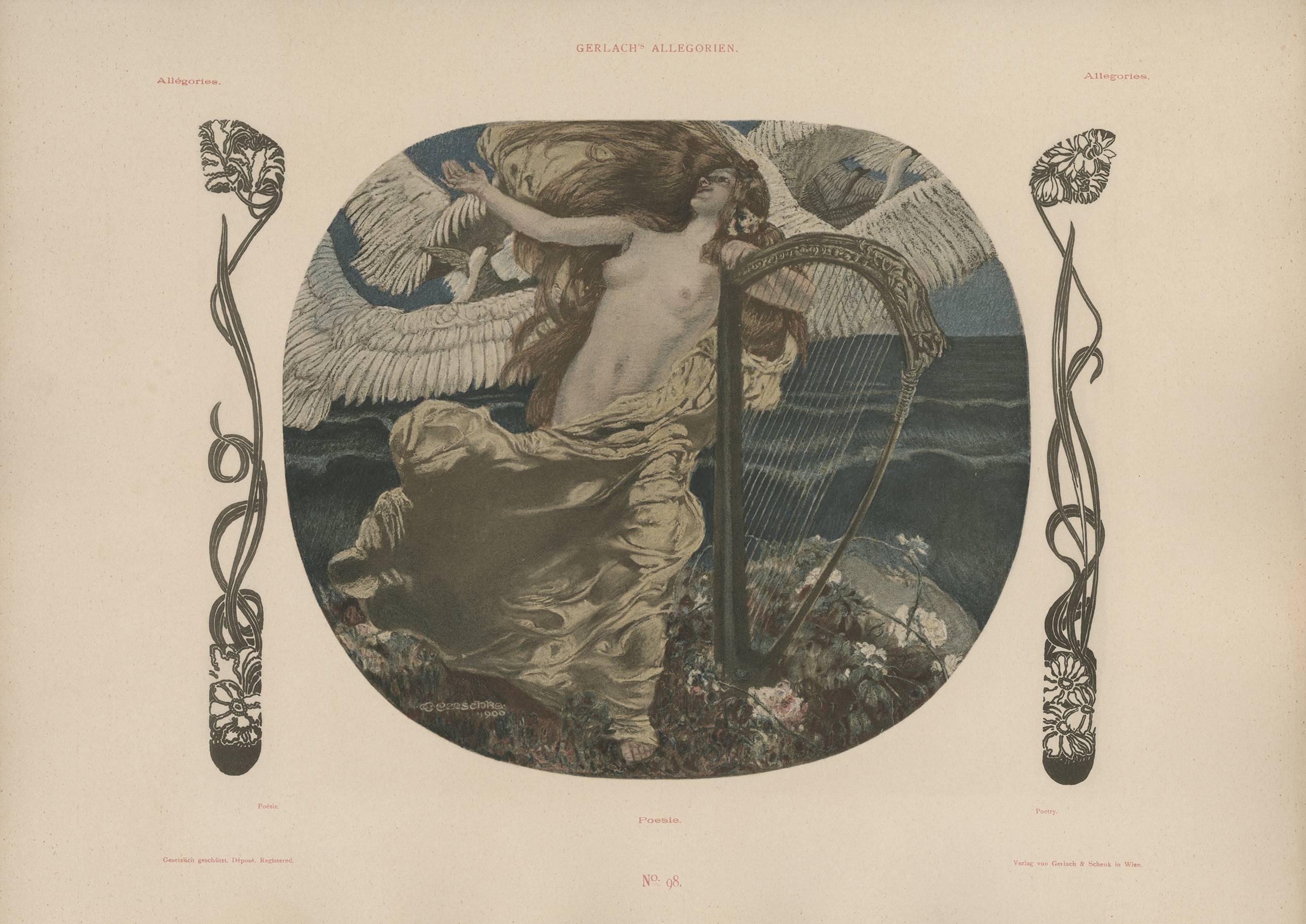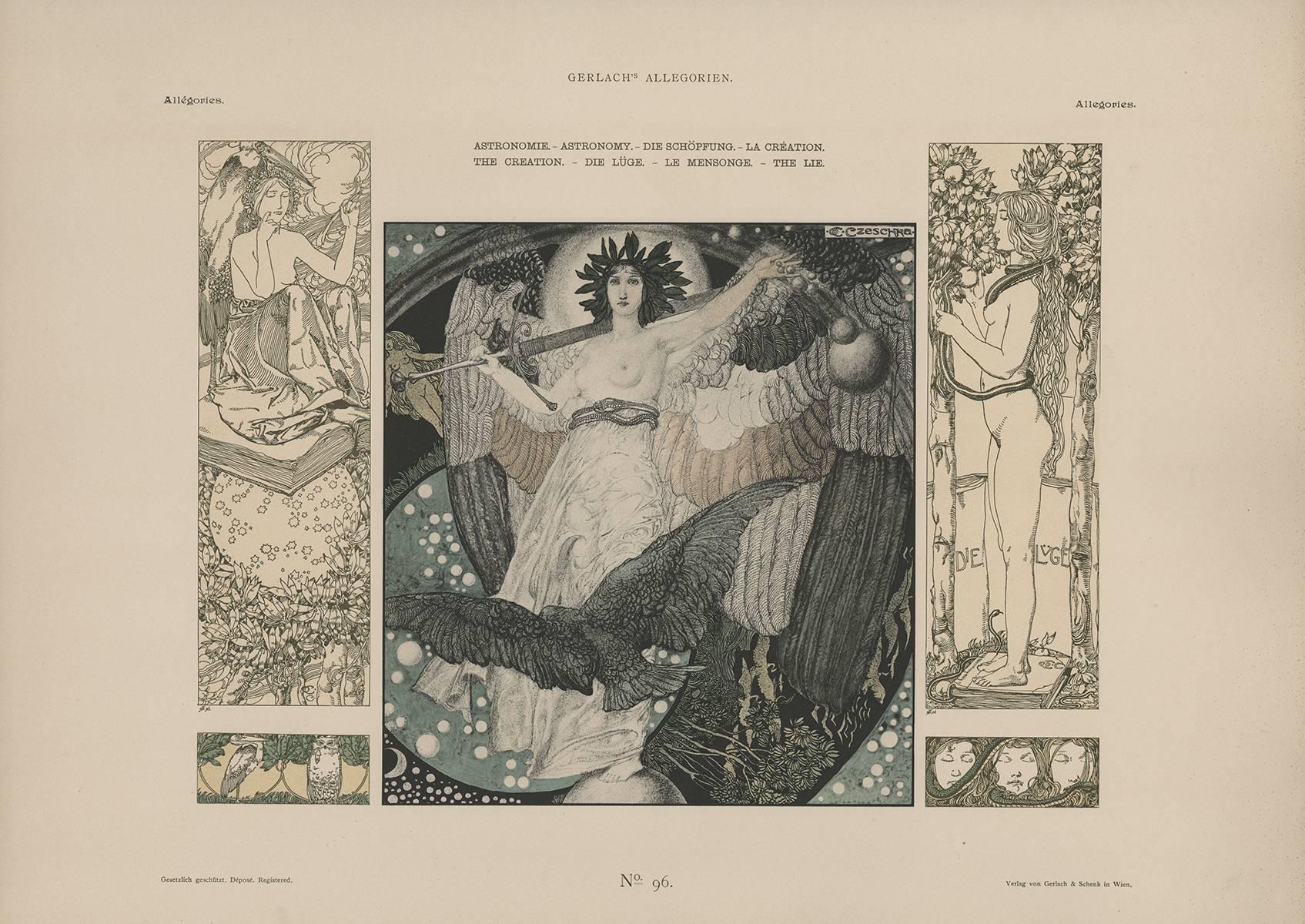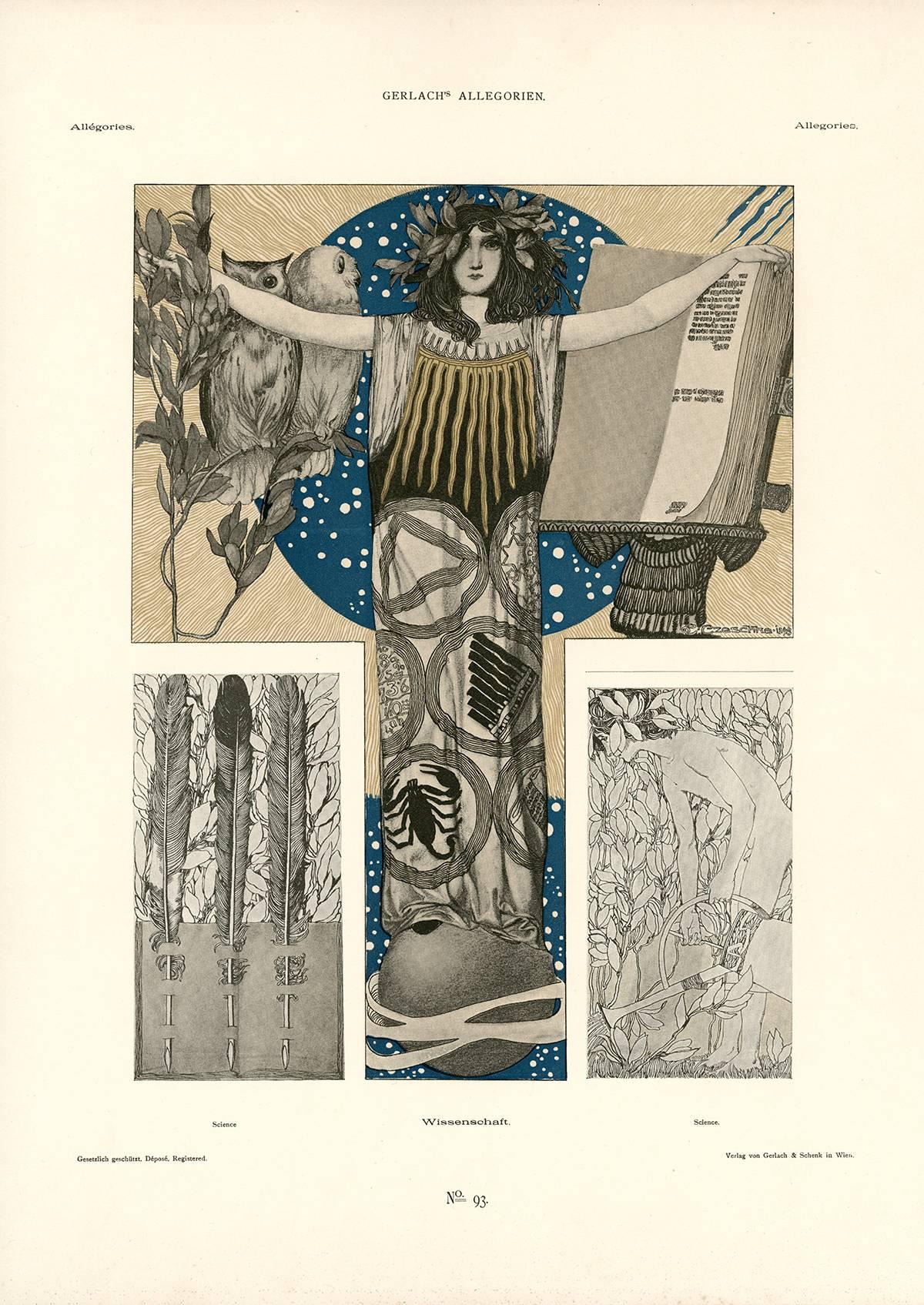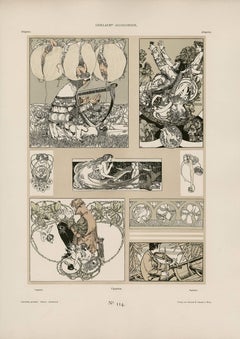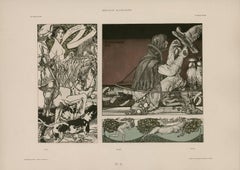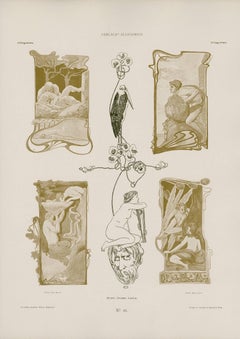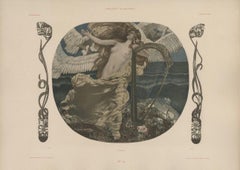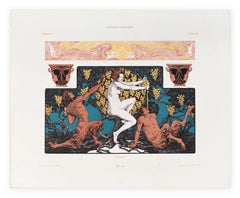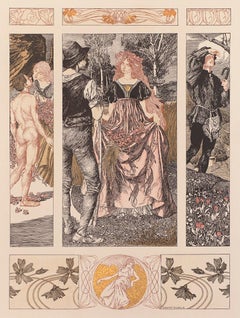Items Similar to Gerlach's Allegorien Plate #78: "Dance & Wine" Lithograph by Carl Otto Czeschka
Want more images or videos?
Request additional images or videos from the seller
1 of 7
Carl Otto CzeschkaGerlach's Allegorien Plate #78: "Dance & Wine" Lithograph by Carl Otto Czeschka1897
1897
$900
£679.85
€785.71
CA$1,264.74
A$1,406.17
CHF 740.44
MX$17,061.12
NOK 9,374.28
SEK 8,762.67
DKK 5,863.44
About the Item
after Carl Otto Czeschka, (1878-1960), Austrian
A leading member of the Vienna Secession and later the Wiener Werkstätte (Viennese Workshop), Carl Otto Czeschka was a vital figure in promoting the idea of Gesamtkunstwerk (total art concept). His extraordinarily fine work in graphic design, furniture, metalwork, textiles and jewelry established his reputation as an artist of the highest rank. Czeschka’s graphic designs, predominantly flat, attenuated, and delicate, represent a departure from the slightly earlier rectilinear styles of Moser and Hoffmann. Instead of checkerboards and grids, we suddenly find delightful vines and flowers that foreshadow the art deco period of the mid-1920s to mid-1930s. Czeschka is perhaps best known today for the eight double-page illustrations for Franz Keim’s abridged Nibelung saga and for the program cover designed for Vienna’s Fledermaus Cabaret. While the artist’s work belongs unmistakably to the avant-garde of fin de siècle Vienna, it continues to appeal to art lovers for its timeless qualities of drama and elegance.
ALLEGORIEN-NEUE FOLGE, 1897, published by Gerlach & Schenk Verlag fur Kunst und Gewerbe, Vienna, was a serial publication that began as Allegorien und Embleme in 1882. A sourcebook of inspiration made for and by young Viennese artists became something of a galvanizer of the modernist movement in Vienna with its new series issued in 1897. Its publisher, Martin Gerlach, plucked young artists and even art students who were exploring the newest techniques in drafting and graphic design to contribute to his publication. This was the beginning of a long-standing relationship. In the forward to the 1897 edition, Gerlach, expounds upon the new approach which consciously shifted away from historicism rooted in the conservative Academy. Instead, the artists were encouraged to explore new subjects and new ways to present them. More unconventional subjects such as: Wine, Love, Song, Music and Dance; Arts and Sciences; the Seasons and their corresponding activities, sports and amusements, breathed fresh, modern life into the allegorical genre. Specific topics that were explored ranged from Electricity and new concepts of Work and Time to Bicycle Sport and the Graphic Arts.
Essentially, the publication served as a portable forum for sharing and disseminating new ideas. Two contributors, a young Gustav Klimt and an even younger Koloman Moser, likely met through their involvement with Allegorien and found themselves to be like-minded artists. As a result, the two allied with other artists and architects in a dramatic and formal break with the established, conservative state-run arts (Kunstlerhausgenessenschaft) to found the Vienna Secession the very next year in 1898. Klimt became the Secession’s first President; while Moser, in 1903, expanded the group from a solely exhibition-based focus to include a workshop by co-founding the Wiener Werkstatte. Gerlach went on to publish some issues of the Secession’s journal called Ver Sacrum as well as postcards designed by its members.
The Viennese art critic, Joseph August, called Gerlach the “Fuhrer der Moderne” (Leader of Modernism). The new 1897 series, featuring its innovative and modern art plates, is an important art historical document as it played a significant role in helping shape the avant-garde art movement in Vienna which exploded onto the scene with the formation of the Vienna Secession in 1898. Individually, the plates are important works; they are noteworthy for their stylistically and thematically modern approach. These plates offer some of the
earliest examples of Viennese avant-garde and Secession artists’ published work.
- Creator:Carl Otto Czeschka (1878 - 1960, Austrian)
- Creation Year:1897
- Dimensions:Height: 13.25 in (33.66 cm)Width: 17.25 in (43.82 cm)
- Medium:
- Movement & Style:
- Period:
- Condition:
- Gallery Location:Chicago, IL
- Reference Number:1stDibs: LU46731447383
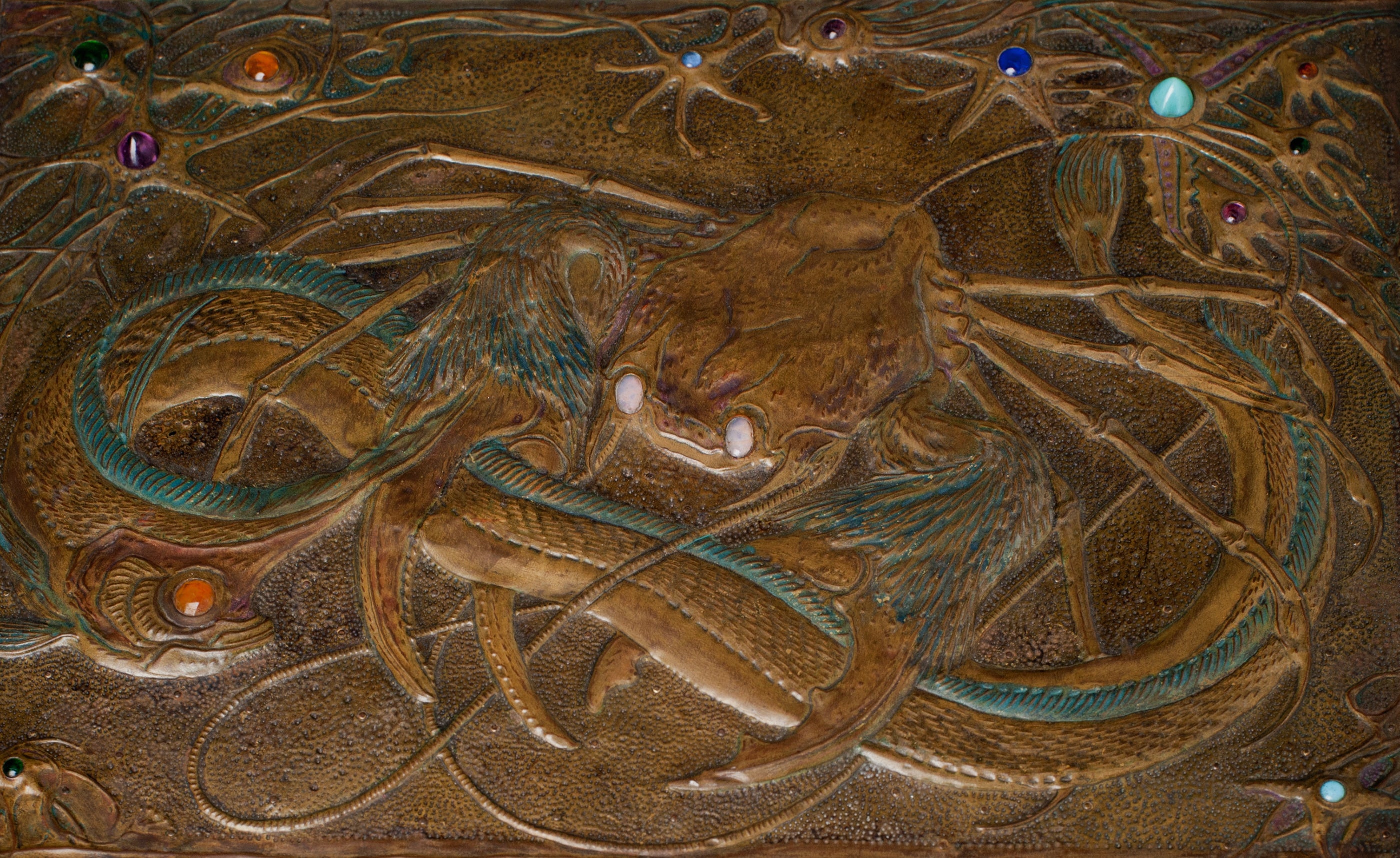
About the Seller
5.0
Gold Seller
Premium sellers maintaining a 4.3+ rating and 24-hour response times
Established in 2013
1stDibs seller since 2016
98 sales on 1stDibs
Typical response time: 6 hours
- ShippingRetrieving quote...Shipping from: Chicago, IL
- Return Policy
Authenticity Guarantee
In the unlikely event there’s an issue with an item’s authenticity, contact us within 1 year for a full refund. DetailsMoney-Back Guarantee
If your item is not as described, is damaged in transit, or does not arrive, contact us within 7 days for a full refund. Details24-Hour Cancellation
You have a 24-hour grace period in which to reconsider your purchase, with no questions asked.Vetted Professional Sellers
Our world-class sellers must adhere to strict standards for service and quality, maintaining the integrity of our listings.Price-Match Guarantee
If you find that a seller listed the same item for a lower price elsewhere, we’ll match it.Trusted Global Delivery
Our best-in-class carrier network provides specialized shipping options worldwide, including custom delivery.More From This Seller
View AllGerlach's Allegorien Plate #114: "Vignettes" Lithograph by Carl Otto Czeschka
By Carl Otto Czeschka
Located in Chicago, IL
after Carl Otto Czeschka, (1878-1960), Austrian
A leading member of the Vienna Secession and later the Wiener Werkstätte (Viennese Workshop), Carl Otto Czeschka was a vital figu...
Category
1890s Vienna Secession Figurative Prints
Materials
Lithograph
Gerlach's Allegorien Plate #85: "Hunting" Lithograph by Carl Otto Czeschka
By Carl Otto Czeschka
Located in Chicago, IL
after Carl Otto Czeschka, (1878-1960), Austrian
A leading member of the Vienna Secession and later the Wiener Werkstätte (Viennese Workshop), Carl Otto Czeschka was a vital figu...
Category
1890s Vienna Secession Figurative Prints
Materials
Lithograph
Gerlach's Allegorien Plate #116: "Force, Thirst, Love" Lithograph
By Carl Otto Czeschka
Located in Chicago, IL
after Carl Otto Czeschka, (1878-1960), Austrian
A leading member of the Vienna Secession and later the Wiener Werkstätte (Viennese Workshop), Carl Otto Czeschka was a vital figu...
Category
1890s Vienna Secession Figurative Prints
Materials
Lithograph
Gerlach's Allegorien Plate #98: "Poetry" Lithograph by Carl Otto Czeschka
By Carl Otto Czeschka
Located in Chicago, IL
after Carl Otto Czeschka, (1878-1960), Austrian
A leading member of the Vienna Secession and later the Wiener Werkstätte (Viennese Workshop), Carl Otto Czeschka was a vital figu...
Category
1890s Vienna Secession Figurative Prints
Materials
Lithograph
Gerlach's Allegorien Plate #78: "Astronomy, The Creation, The Lie" Lithograph
By Carl Otto Czeschka
Located in Chicago, IL
after Carl Otto Czeschka, (1878-1960), Austrian
A leading member of the Vienna Secession and later the Wiener Werkstätte (Viennese Workshop), Carl Otto Czeschka was a vital figu...
Category
1890s Vienna Secession Figurative Prints
Materials
Lithograph
Gerlach's Allegorien Plate #93: "Science" Lithograph by Carl Otto Czeschka
By Carl Otto Czeschka
Located in Chicago, IL
after Carl Otto Czeschka, (1878-1960), Austrian
A leading member of the Vienna Secession and later the Wiener Werkstätte (Viennese Workshop), Carl Otto Czeschka was a vital figu...
Category
1890s Vienna Secession Figurative Prints
Materials
Lithograph
You May Also Like
The Thirst, Plate 52 from Gerlach's Allegorien, Vienna Secession lithograph
Located in Chicago, IL
Wilhelm List, a friend and follower of Gustav Klimt, was a founder and leading member of the Vienna Secession and contributor to its official magazine, Ver Sacrum...
Category
1890s Vienna Secession Prints and Multiples
Materials
Lithograph
Alphonse Mucha's "Figures Decoratives" 1905 Art Nouveau Lithograph, Plate 37
By Alphonse Mucha
Located in Chicago, IL
Plate 37 from Alphonse Mucha's Figures Decoratives, a folio of forty color lithographic plates published by Librairie centrale des beaux-arts in 1905.
Issued during a period of incr...
Category
Early 1900s Art Nouveau Prints and Multiples
Materials
Lithograph
Spring by Robert Engels, Medieval Art Nouveau lithograph with gold ink, 1897
By Robert Engels
Located in Chicago, IL
Allegorien-Neue Folge was a serialized folio published in installments between 1895 and 1900. Martin Gerlach, its publisher, was inspired by the rise of modernist design in Vienna an...
Category
1890s Vienna Secession Prints and Multiples
Materials
Lithograph
La Danse (The Dance) - Original lithograph - 1897
By Armand Rassenfosse
Located in Paris, IDF
Armand Rassenfosse
La Danse, 1897
Original lithograph
Printed signature in the plate
On paper 40 x 31 cm (c. 16 x 12")
INFORMATION : Published by 'Estampe Moderne, Paris, 1897-1899...
Category
1890s Art Nouveau Figurative Prints
Materials
Lithograph
Late 19th century color lithograph art nouveau ornate bookplate figures floral
By Alphonse Mucha
Located in Milwaukee, WI
"Dream Weavers" and "Soul of the Land" are two sides of a double-sided lithograph by Alphonse Mucha. These illustrations were created for "Ilsee, Princess of Tripoli" and are the rare proofs before the text. These artworks were for pages 31 and 32.
8" x 6 1/4" art
19 1/4" x 17 1/8" frame
Alphonse Mucha was born in 1860 in the small town of Ivancice, Monrovia. Though it is rumored that Mucha was drawing before he was walking, his early years were spent as a choirboy and amateur musician. It wasn’t until after he finished high school that he came to realize that living people were responsible for the art that he admired in the local churches. That epiphany made him determined to become a painter. He was soon sent off to Paris, where he studied at the Academie Julian. On January 1, 1985, he presented his own new style to the citizens of Paris. Spurning the bright colors and the more square-like shape of the more popular poster artists, the design was a sensation. Art Nouveau can...
Category
1890s Art Nouveau Figurative Prints
Materials
Lithograph
Bacchantes and Musicians - Original Lithograph by Ferdinand Bac - 1922
Located in Roma, IT
Bacchantes and Musicians is an original modern artwork realized by Ferdinand Bac (1859 - 1952) in 1923.
Signed and dated on plate on the lower left corn...
Category
1920s Art Nouveau Figurative Prints
Materials
Lithograph
